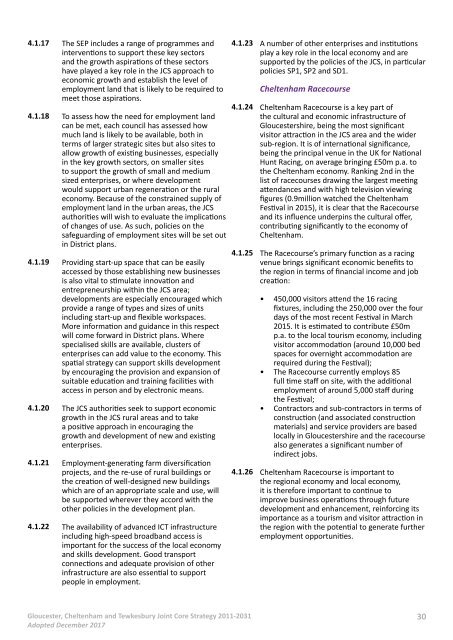JCS_MasterDocument_FIN_27.03.18
Create successful ePaper yourself
Turn your PDF publications into a flip-book with our unique Google optimized e-Paper software.
4.1.17<br />
4.1.18<br />
4.1.19<br />
4.1.20<br />
4.1.21<br />
4.1.22<br />
The SEP includes a range of programmes and<br />
interventions to support these key sectors<br />
and the growth aspirations of these sectors<br />
have played a key role in the <strong>JCS</strong> approach to<br />
economic growth and establish the level of<br />
employment land that is likely to be required to<br />
meet those aspirations.<br />
To assess how the need for employment land<br />
can be met, each council has assessed how<br />
much land is likely to be available, both in<br />
terms of larger strategic sites but also sites to<br />
allow growth of existing businesses, especially<br />
in the key growth sectors, on smaller sites<br />
to support the growth of small and medium<br />
sized enterprises, or where development<br />
would support urban regeneration or the rural<br />
economy. Because of the constrained supply of<br />
employment land in the urban areas, the <strong>JCS</strong><br />
authorities will wish to evaluate the implications<br />
of changes of use. As such, policies on the<br />
safeguarding of employment sites will be set out<br />
in District plans.<br />
Providing start-up space that can be easily<br />
accessed by those establishing new businesses<br />
is also vital to stimulate innovation and<br />
entrepreneurship within the <strong>JCS</strong> area;<br />
developments are especially encouraged which<br />
provide a range of types and sizes of units<br />
including start-up and flexible workspaces.<br />
More information and guidance in this respect<br />
will come forward in District plans. Where<br />
specialised skills are available, clusters of<br />
enterprises can add value to the economy. This<br />
spatial strategy can support skills development<br />
by encouraging the provision and expansion of<br />
suitable education and training facilities with<br />
access in person and by electronic means.<br />
The <strong>JCS</strong> authorities seek to support economic<br />
growth in the <strong>JCS</strong> rural areas and to take<br />
a positive approach in encouraging the<br />
growth and development of new and existing<br />
enterprises.<br />
Employment-generating farm diversification<br />
projects, and the re-use of rural buildings or<br />
the creation of well-designed new buildings<br />
which are of an appropriate scale and use, will<br />
be supported wherever they accord with the<br />
other policies in the development plan.<br />
The availability of advanced ICT infrastructure<br />
including high-speed broadband access is<br />
important for the success of the local economy<br />
and skills development. Good transport<br />
connections and adequate provision of other<br />
infrastructure are also essential to support<br />
people in employment.<br />
4.1.23<br />
4.1.24<br />
4.1.25<br />
4.1.26<br />
A number of other enterprises and institutions<br />
play a key role in the local economy and are<br />
supported by the policies of the <strong>JCS</strong>, in particular<br />
policies SP1, SP2 and SD1.<br />
Cheltenham Racecourse<br />
Cheltenham Racecourse is a key part of<br />
the cultural and economic infrastructure of<br />
Gloucestershire, being the most significant<br />
visitor attraction in the <strong>JCS</strong> area and the wider<br />
sub-region. It is of international significance,<br />
being the principal venue in the UK for National<br />
Hunt Racing, on average bringing £50m p.a. to<br />
the Cheltenham economy. Ranking 2nd in the<br />
list of racecourses drawing the largest meeting<br />
attendances and with high television viewing<br />
figures (0.9million watched the Cheltenham<br />
Festival in 2015), it is clear that the Racecourse<br />
and its influence underpins the cultural offer,<br />
contributing significantly to the economy of<br />
Cheltenham.<br />
The Racecourse’s primary function as a racing<br />
venue brings significant economic benefits to<br />
the region in terms of financial income and job<br />
creation:<br />
• 450,000 visitors attend the 16 racing<br />
fixtures, including the 250,000 over the four<br />
days of the most recent Festival in March<br />
2015. It is estimated to contribute £50m<br />
p.a. to the local tourism economy, including<br />
visitor accommodation (around 10,000 bed<br />
spaces for overnight accommodation are<br />
required during the Festival);<br />
• The Racecourse currently employs 85<br />
full time staff on site, with the additional<br />
employment of around 5,000 staff during<br />
the Festival;<br />
• Contractors and sub-contractors in terms of<br />
construction (and associated construction<br />
materials) and service providers are based<br />
locally in Gloucestershire and the racecourse<br />
also generates a significant number of<br />
indirect jobs.<br />
Cheltenham Racecourse is important to<br />
the regional economy and local economy,<br />
it is therefore important to continue to<br />
improve business operations through future<br />
development and enhancement, reinforcing its<br />
importance as a tourism and visitor attraction in<br />
the region with the potential to generate further<br />
employment opportunities.<br />
Gloucester, Cheltenham and Tewkesbury Joint Core Strategy 2011-2031<br />
Adopted December 2017<br />
30




